
NGC 1097 is a barred spiral galaxy about 45 million light years away in the constellation Fornax. It was discovered by William Herschel on 9 October 1790. It is a severely interacting galaxy with obvious tidal debris and distortions caused by interaction with the companion galaxy NGC 1097A.
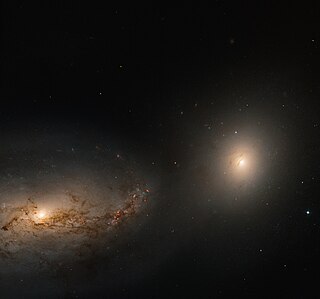
NGC 3227 is an intermediate spiral galaxy that is interacting with the dwarf elliptical galaxy NGC 3226. The two galaxies are one of several examples of a spiral with a dwarf elliptical companion that are listed in the Atlas of Peculiar Galaxies. Both galaxies may be found in the constellation Leo. It is a member of the NGC 3227 Group of galaxies, which is a member of the Leo II Groups, a series of galaxies and galaxy clusters strung out from the right edge of the Virgo Supercluster.

NGC 514 is a low-luminosity, intermediate spiral galaxy in the equatorial constellation of Pisces, located at a distance of approximately 83 million light-years from the Milky Way. It was discovered on 16 October 1784 by astronomer William Herschel. The general form of the galaxy is specified by its morphological classification of SAB(rs)c, which indicates it has a weak bar system at the core (SAB), an incomplete ring formation around the bar (rs), and somewhat loosely-wound spiral arms (c). This galaxy has an H II nucleus with an extended region that displays weak emission lines in the optical range, but not in the near infrared. The suspected supermassive black hole at the core has an estimated mass of 3.2×106 M☉.

NGC 7479 is a barred spiral galaxy about 105 million light-years away in the constellation Pegasus. William Herschel discovered it in 1784. NGC 7479 is also recognized as a Seyfert galaxy and a LINER undergoing starburst activity not only on the nucleus and the outer arms, but also across the bar of the galaxy, where most of the stars were formed in the last 100 million years. Polarization studies of this galaxy indicate that it recently underwent a minor merger and that it is unique in the radio continuum, with arms opening in a direction opposite to the optical arms. This feature, along with the asymmetrical arms of the galaxy and the intense star formation activity are attributed to a merger with a smaller galaxy. This galaxy is similar in both size and morphology to the barred spiral NGC 1300.

NGC 5548 is a Type I Seyfert galaxy with a bright, active nucleus. This activity is caused by matter flowing onto a 65 million solar mass (M☉) supermassive black hole at the core. Morphologically, this is an unbarred lenticular galaxy with tightly-wound spiral arms, while shell and tidal tail features suggest that it has undergone a cosmologically-recent merger or interaction event. NGC 5548 is approximately 245 million light years away and appears in the constellation Boötes. The apparent visual magnitude of NGC 5548 is approximately 13.3 in the V band.

NGC 5005, also known as Caldwell 29, is an inclined spiral galaxy in the constellation Canes Venatici. The galaxy has a relatively bright nucleus and a bright disk that contains multiple dust lanes. The galaxy's high surface brightness makes it an object that is visible to amateur astronomers using large amateur telescopes.
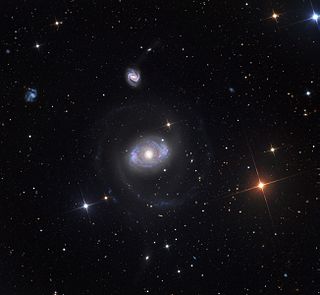
NGC 4151 is an intermediate spiral Seyfert galaxy with weak inner ring structure located 15.8 megaparsecs from Earth in the constellation Canes Venatici. The galaxy was first mentioned by William Herschel on March 17, 1787; it was one of the six Seyfert galaxies described in the paper which defined the term. It is one of the nearest galaxies to Earth to contain an actively growing supermassive black hole. The black hole would have a mass on the order of 2.5 million to 30 million solar masses. It was speculated that the nucleus may host a binary black hole, with about 40 million and about 10 million solar masses respectively, orbiting with a 15.8-year period. This is, however, still a matter of active debate.
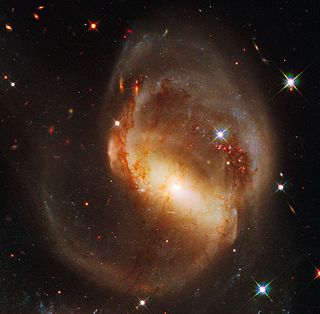
NGC 7319 is a highly distorted barred spiral galaxy that is a member of the compact Stephan's Quintet group located in the constellation Pegasus, some 311 megalight-years distant from the Milky Way. The galaxy's arms, dust and gas have been highly disturbed as a result of the interaction with the other members of the Quintet. Nearly all of the neutral hydrogen has been stripped from this galaxy, most likely as a result of a collision with NGC 7320c some 100 million years ago. A pair of long, parallel tidal tails extend southward from NGC 7319 in the direction of NGC 7320c, and is undergoing star formation.

NGC 2681 is a lenticular galaxy in the constellation Ursa Major. The galaxy lies 50 million light years away from Earth, which means, given its apparent dimensions, that NGC 2681 is approximately 55,000 light years across. NGC 2681 has an active galactic nucleus and it is a type 3 Seyfert galaxy. Its nucleus is also a low-ionization nuclear emission-line region.

NGC 3147 is a spiral galaxy located in the constellation Draco. It is located at a distance of circa 130 million light years from Earth, which, given its apparent dimensions, means that NGC 3147 is about 140,000 light years across. It was discovered by William Herschel on April 3, 1785. It is a Type II Seyfert galaxy.

NGC 7469 is an intermediate spiral galaxy in the constellation of Pegasus. NGC 7469 is located about 200 million light-years away from Earth, which means, given its apparent dimensions, that NGC 7469 is approximately 90,000 light-years across. It was discovered by William Herschel on November 12, 1784.

NGC 7213 is a lenticular galaxy located in the constellation Grus. It is located at a distance of circa 70 million light-years from Earth, which, given its apparent dimensions, means that NGC 7213 is about 75,000 light-years across. It was discovered by John Herschel on September 30, 1834. It is an active galaxy with characteristics between a type I Seyfert galaxy and LINER.

NGC 7130 is a spiral galaxy located in the constellation Piscis Austrinus. It is located at a distance of about 220 million light years from Earth, which, given its apparent dimensions, means that NGC 7130 is about 100,000 light years across. It was discovered by John Herschel on September 25, 1834, and discovered independently by Lewis Swift on September 17, 1897. The location of the galaxy given in the New General Catalogue was off by 30 arcminutes in declination from the location of the galaxy.

NGC 7674 is a spiral galaxy located in the constellation Pegasus. It is located at a distance of about 350 million light years from Earth, which, given its apparent dimensions, means that NGC 7674 is about 125,000 light years across. It was discovered by John Herschel on August 16, 1830.
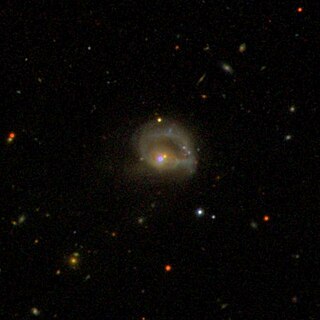
NGC 985 is a ring galaxy in the constellation of Cetus. It is located about 550 million light years away from Earth, which means, given its apparent dimensions, that NGC 985 is approximately 160,000 light years across. It was discovered by Francis Leavenworth in 1886. It is a type 1 Seyfert galaxy.

NGC 931 is a spiral galaxy located in the constellation Triangulum. It is located at a distance of circa 200 million light-years from Earth, which, given its apparent dimensions, means that NGC 931 is about 200,000 light years across. It was discovered by Heinrich d'Arrest on September 26, 1865. It is classified as a Seyfert galaxy.
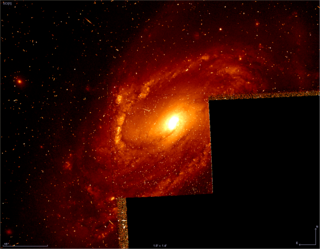
NGC 1241 is a spiral galaxy located in the constellation Eridanus. It is located at a distance of circa 150 million light years from Earth, which, given its apparent dimensions, means that NGC 1241 is about 140,000 light years across. It was discovered by William Herschel on January 10, 1785. It is classified as a Seyfert galaxy.

NGC 3393 is a barred spiral galaxy located in the constellation Hydra. It is located at a distance of circa 180 million light-years from Earth, which, given its apparent dimensions, means that NGC 3393 is about 140,000 light-years across. It was discovered by John Herschel on March 24, 1835. It is a Type II Seyfert galaxy, known to host two supermassive black holes, which are the nearest known pair of supermassive black holes to Earth.

NGC 4593 is a barred spiral galaxy located in the constellation Virgo. It is located at a distance of about 120 million light years from Earth, which, given its apparent dimensions, means that NGC 4593 is about 125,000 light years across. It was discovered by William Herschel on April 17, 1784. It is a Seyfert galaxy.

NGC 4253 is a barred spiral galaxy located in the constellation Coma Berenices. It is located at a distance of about 185 million light years from Earth, which, given its apparent dimensions, means that NGC 4253 is about 65,000 light years across. It was discovered by William Herschel on February 3, 1788. It is a Seyfert galaxy.





















